|
Odeon Theatre Manchester Road, Bradford.

Location The Odeon Theatres cinema chain pioneered by Oscar Deutsch in the early 1930s was expanding rapidly throughout the country and the flagship of the group, the Odeon Theatre in London's Leicester Square, had been opened in 1937. The following year Deutsch had set his sights on Bradford. In 1938 Bradford was a prosperous city and awash with money through its wool, textile and engineering industries and Deutsch saw the city as the place to be and viewed this site for his new theatre. Deutsch had observed that only a few hundred yards away was the beautiful domed Alhambra Theatre and, more importantly, next to it was the huge and sumptuous New Victoria Theatre/cinema, ballroom and restaurant complex with a cinema capacity of 3318 seats. These factors required Deutsch to come up with something rather special for Bradford in order to compete effectively. The Building Designed by architect Robert Bullivant of Harry W. Weedon, FRIBA & Partners of Birmingham who were responsible for designing many other Odeons in the chain. As a point of interest, Oscar Deutsch's first Odeon in 1933 was at Perry Barr in Birmingham. Much use was made of the location and natural slope of Manchester Road in the design and layout of the building. The cinema butted on to the side of the existing Oddfellows Arms public house and was set back from the line of the other older buildings in that part of Manchester Road and so providing a vast pavement area in front of the entrance. The original artists impression of the proposed new Odeon did include a semi-circular all-glass end to the shop units at the city end of the building. This was intended to accommodate access to a restaurant but this feature was never included in the actual final construction. Also more glass was added to the distinctive tower than was originally conceived by the (uncredited) artist. The imposing frontage had a wide entrance of five oak and glass pairs of double doors with a second set of doors inside. Above the wide canopy was a massive glass window of the circle lounge topped by the name 'Odeon'. To the left of the entrance was a huge tower largely of glass of which more later. To the left of the entrance was a parade of shop units with two floors of office accommodation above and all facing on to Manchester Road making a most imposing façade. The cinema auditorium ran lengthways following the slope of the road and positioned behind the shops and office/flat units. The exterior frontage of the Odeon, shops and offices were clad in black tiles at street level with cream faience tiles above and three horizontal bands of colour across the top. This block was constructed slightly lower than the original artists design. The exterior was brilliantly illuminated with the lit chandeliers of the circle foyer/lounge sparkling through the huge windows together with lights all the way up the continuous vertical glass window of the tower. The all-glass top of the tower was radiant in red/green coloured neon lighting making it a landmark visible across the city. Behind this impressive frontage, the rest of the building was of red brick with a flat roofed area above the projection room at one end and the small stage extension at the other end. The long narrow auditorium roof was flat-topped down its centre and sloping sides and the whole auditorium roof sloped from the projection area down to the stage area. The shop/office units had a uniform flat roof. There was a large car parking space at the rear of the building with access via Nelson Court and pedestrian access from Fawcett Court and Fawcett Row from Nelson Street. Oscar Deutsch had achieved his aim to make all his new Odeons immediately recognisable with similar design features and styles based on an idea used earlier by Woolworths with their uniform store fronts. The cost of erecting the Bradford Odeon was reported variously as £65,000 to £80,000 - an enormous sum in those days and Oscar Deutsch hoped that Bradford would be proud of its new entertainment facility. Sub-Contractors 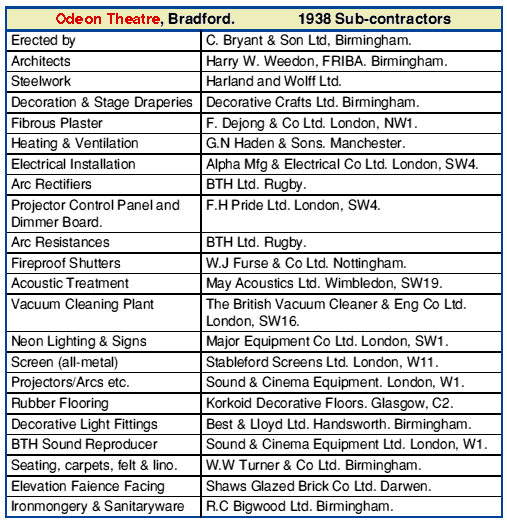 The Interior - Foyers The circle foyer/lounge with its high ceiling and art deco chandeliers and imposing gigantic window was fully carpeted and comfortable settees lined the walls. Such large foyers provided ample space for promotional displays, small exhibitions and sales counters. Decorations were in pastel shades. Interior - Auditorium 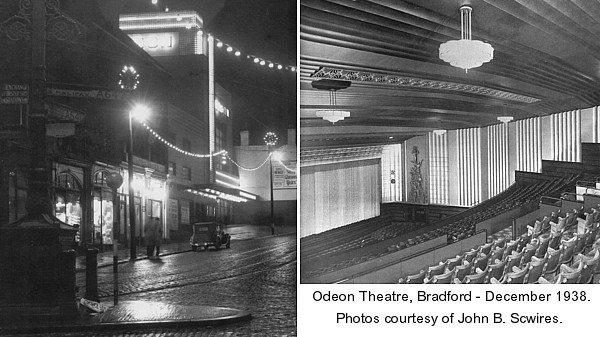 The huge circle was entered via a central vomitorium from the circle foyer. During its construction the circle was supported across its width by a steel girder (from Dawnays Ltd, Battersea) 97 feet long and weighing 51.1/2 tons. It arrived in Bradford by LMS railway on 10th January 1938 amid much publicity as it was the biggest girder ever seen in the city. From the circle you could best appreciate the uniformity of design and decor linking the side walls and ceiling with 'fluting' giving a gentle wave effect. Graduated colours of silver at the back to gold at the front (proscenium opening) to blend with the gold stage curtains - the whole effect being very restful. There was very smart walnut and black wall panelling along the side aisles. Suspended chandelier light fittings provided a soft amber light to the auditorium. Odeon Theatres described the decorations as being "in the modern abstract style, but restrained and dignified so that the effect as a whole is one of quiet blending of colours". The proscenium and its surround were very striking with indirect (ie. concealed) lighting carried around the proscenium opening at 38 feet wide and 14 feet deep to accommodate the well set-back screen and speakers. Two small dressing rooms were provided. The all-metal type of screen used by the Odeon was claimed to vastly improve the sound reception in the auditorium. The seating upholstery and carpeting was "of a pleasing tint tending to autumn gold and lending warmth to the already very inviting hall" said a local newspaper. Gilded Lilies No Organ! It seems Oscar Deutsch was not too keen on the expense of organs or acts on the stage for that matter and preferred to offer a wholesome film programme. So it is that very few Odeons were ever equipped with organs though he did choose to include a 5-manual Compton in his smaller but flagship Odeon Leicester Square. Projection Room 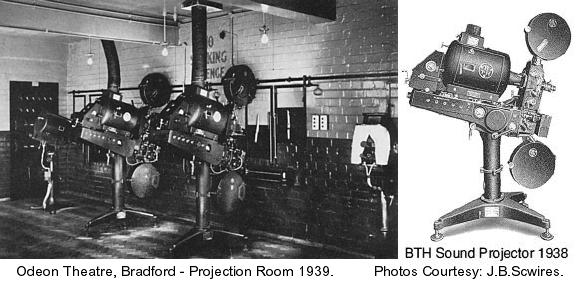 Original equipment included two BTH (British Thompson-Houston) projectors with BTH arcs and, of course, BTH sound system. A third projector was installed for a short period of time. At each end of the projection room were an arc follow spot and an arc slide projector respectively. The Opening The opening on Saturday 17th December 1938 coincided with a special Christmas fortnight of shopping in the Manchester Road area. The impressive and gleaming new landmark building with its exterior colour lighting display was supported by fairy lights in Manchester Road and special illuminated shop window displays creating a glowing festive scene. With every pre-booked seat sold out within an hour, the opening ceremony was performed by the Lord Mayor of Bradford (Alderman Tom J. Robinson) supported by a distinguished assembly including . . . The capacity audience were treated to the programme . . . 1. National AnthemA collection was taken in aid of the Bradford Cinderella Club and Hest Bank Holiday Home near Morecambe. Clive Brook praised Bradford's "beautiful theatre" to enthusiastic applause. Opening night anecdote . . . The following week from Monday 19th December 1938 the Odeon advertised "On with the show and long may we serve you" and the public queued in their thousands to see . . . "The Challenge" - 1938 UK B/W 75 minsAdmission prices were Stalls 9d, 1/-. Circle 1/3, 1/6. The new Odeon was able to offer real competition in terms of quality films and audience comfort to the gigantic New Victoria Theatre only a few hundred yards away, though the 'New Vic' did also offer stage shows and organ interludes. The Odeon also had an immediate effect on two other cinemas each less than a quarter of a mile away - The Tatler in Thornton Road fought back by advertising . . . Grand Concert Sunday 5th January 1939 at 7.45pm A Musical Experiment "The Mikado" - 1939 UK B/W 75 minsShown on two projectors (for reel changeover continuity) in the usual manner but with the musical scenes duplicated on the third projector. At the end of each song the audience were invited to applaud. If the applause warranted it, the song was screened again on the third projector. This novel arrangement upset the screening timetable but music lovers certainly had value for money. Wartime Bomb Damage On the night of Saturday August 31st 1940, Hitler's Luftwaffe gave Bradford its biggest pounding of the war with bombs dropped across the city totally destroying many buildings including Lingards department store, Rawson fruit market and part of a second market. Bombs also dropped on the Odeon Theatre. The film had just finished its run . . . "It's a Date" - 1940 USA B/W 103 mins.Ten minutes after the cinema had cleared, the bombs dropped crashing through the roof into the front stalls and causing fires instantly. As the ceiling came down heavy metal chandeliers crashed on to the seats. The stage fittings, screen, footlights, orchestra pit and front stalls seats were destroyed. The landmark glass tower and the entrance frontage were also damaged.  The fire brigade stationed nearby in Nelson Street were quick on to the scene. The projectionist, Mr Gilmartin, was still in the building and was able to help extinguish the fires. If he had left a couple of minutes earlier he would have been in his car parked at the back of the cinema and wrecked beneath a pile of debris which had fallen. Grand Re-opening The Grand Re-opening Ceremony took place on Monday 11th November 1940 at 6.00pm with proceeds in aid of the Lord Mayor's Services Comforts Fund. The film was the Provincial Premier of . . . "Rangers of Fortune" - 1940 USA B/W 80 mins.Performing live on stage that evening were . . . The Royal Air Force (Aero Notes) BandThe stage ensemble for the re-opening ceremony included: The Lord Mayor and Lady Mayoress (Alderman William Illingworth and Mrs Illingworth) Frances Day (famous screenstar) W.G Elcock - Director of Odeon Theatres Ltd. J.M Yardley - General Manager of the cinema It's worth mentioning that the Lord Mayor, Alderman William Illingworth, was no stranger to cinemas for as an architect by profession he had previously designed the Prince's Hall in Shipley, the Saltaire Picture House and the sumptuous New Victoria Theatre complex in Bradford. Click here for more details of William Illingworth. The assistant general manager at this time was A.C Swift. From Tuesday 12th November 1940 Bradfordian's flocked to see . . . "Lillian Russell" - 1940 USA B/W 127 mins.Oscar Deutsch died in 1941 and his widow, Lily Deutsch sold his then 305 Odeon circuit to J. Arthur Rank to run alongside his Gaumont circuit resulting in Rank now had four cinemas, New Victoria Theatre, Morley Street Picture House, St George's Hall and Odeon Theatre all in the centre of Bradford. The wartime and the years that followed were a boom time for the Odeon and indeed for most cinemas until the arrival of television in the area in 1952. Children's Club There was no organ in the Bradford Odeon but an upright piano was available to accompany the many singalongs with slides of words on the screen. The Bradford ONCC competed keenly with similar clubs at the New Victoria and the ABC Minors at the Ritz cinema. The piano was later painted white for the manager of the time, Arthur Riley, who entertained the children with his Al Jolson singing impressions. Widescreen - CinemaScope & VistaVision Week commencing Monday 8th March 1954.Prices were now 1/3 to 3/6 (inc. tax). Three channel (left, centre and right) stereo sound was installed with speakers behind the screen. The fourth ambient channel (required by 20th Century Fox) adding a surround effect around the auditorium was never installed. 
Another new widescreen picture format was shown for the first time in Bradford - it was in VistaVision - a new high definition process from Paramount. Opening on Monday 3rd January 1955 was . . . The World's First Motion Picture in VistaVision Closure for Major Alterations The Bradford Odeon was one of a number throughout the country with good profitability to be chosen for reconstruction and modernisation, the chief feature being the opening out of the foyer and new styled entrance. This involved removing half of the floor of the old circle lounge giving additional height. A dual staircase was installed running up either side of the foyer to meet on a new bridge leading to the circle landing - this effect was to give spaciousness. New glass doors were fitted at the main entrance and between these and another set of glass doors leading into the foyer itself was a new paybox. A stylish new sales kiosk was constructed in the middle of the foyer. Deep pile carpet in red with black design was fitted throughout the huge foyer. 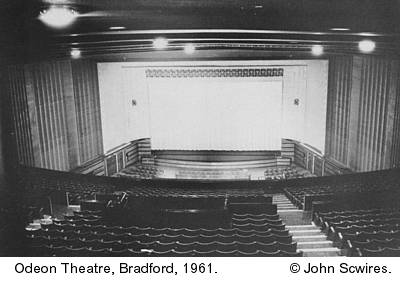
Decorations were in contemporary style with ceilings in two shades of blue - deep French and the lighter Pompadour colour. The walls were in flame red with wall panels papered in a mix of grey and black. Lighting was provided by contemporary style cluster lights in Danish glass. A new illuminated sign was erected outside. The auditorium and proscenium also received a facelift with the stage lighting (footlights and overhead battens) being replaced by a system of pageant lighting fixed to the front of the circle which focused nine 1000 watt bulbs on to the new gold colour screen curtains. To set this off, the proscenium surround had been painted gold. The spacing between rows of seats was increased but the expense of removing over 200 seats giving a new capacity of 2447. Heating was improved by converting the boilers to an oil-burning system thermostatically controlled. The manager, Jack Fenner, also got new uniforms for all the staff. Contractors Another Re-opening "Tunes of Glory" - 1960 UK Technicolor 106 minsAdmission prices were now 3/- to 5/-. Several decades later (2005) people still recall the impression made by John Mills in the "dapper light grey classic suit as he walked back up the aisle waving and smiling" to a delighted and appreciative audience. Odeon Buildings - The Shops Scott, Myers & Co - Auctioneers, estate agents. Council Buys Lease Bradford City Council had other ideas as they saw the Odeon as an obstacle to the grand plan (the Wardley plan) for the re-organisation and rebuilding of the city centre and the Odeon site was needed for the new Magistrates Courts. By 1968 the Oddfellows public house adjoining the Odeon had been demolished and the roadway encircling the Jacobs Well roundabout built across the pub site opposite the Central Library. The course of Manchester Road was to be diverted from in front of the Odeon westwards towards the Alhambra Theatre (as it is now) an so leaving the Odeon on a large island along with older properties at the rear. Final Closure "The Thomas Crown Affair" - 1968 USA Color de Luxe 102 minsIt was a sad day for cinemagoers as the city had lost another of its three grand 'super-cinema' - the others were the Gaumont closed in 1968 for 'twinning' and Ritz still operating at that time. At its closure the Odeon's advertising proclaimed . . . The name 'Odeon' was transferred to the new converted 'twins' (and later triple) units. This transfer of name from one building to another has caused much confusion since particularly with press and peoples reminiscences of the cinema. Demolition A major difficulty encountered was the massive 51.1/2 tons steel girder which supported the centre circle and spanned the full width of the auditorium part of the building. When exposed after thirty years it was found to be "as good as new" and it had to be cut into several sections before it could be removed. During the demolition one of the workers fell 50 feet to the ground and on re-visiting the site later aided by a Zimmer frame and with his body encased in a cage, he was asked how it felt as he fell to the ground. The quick thinking Irishman replied "The fall wasn't too bad, it was the sudden stop that shocked me". 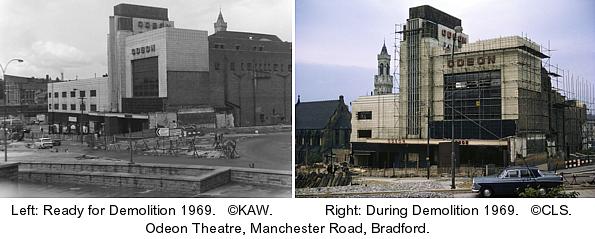 After the area was cleared, the new Magistrates Courts and gardens were built on the site and remain there today in 2010. Origin of the 'Odeon' Name Thus the name was adopted by Oscar Deutsch (a former metal broker of Birmingham) founder of the Odeon Theatres circuit. The name Odeon has been jokingly used as an acronym for "Oscar Deutsch Entertains (or Entertaining) Our Nation" and as such is fairly well known. The fact is that the first Odeon at Perry Barr was opened before the chain of cinemas grew and before someone thought of the acronym which actually turned out to be quite appropriate in later years. After the death of Oscar Deutsch in 1941 the Odeon circuit was sold to J. Arthur Rank and later joined with Gaumont to become CMA - Circuit Management Association and the largest circuit in the country. Addendum - Leeds Odeon May not be copied or reproduced without permission.
|
 The second World War had started in September 1939 and the spectacular exterior lighting displays had to be switched off in accordance with government blackout regulations.
The second World War had started in September 1939 and the spectacular exterior lighting displays had to be switched off in accordance with government blackout regulations. The first showing of a CinemaScope (a 20th Century Fox innovation) film in Bradford city centre was at the nearby Gaumont Theatre with "How to Marry a Millionaire" in February 1954.
The first showing of a CinemaScope (a 20th Century Fox innovation) film in Bradford city centre was at the nearby Gaumont Theatre with "How to Marry a Millionaire" in February 1954.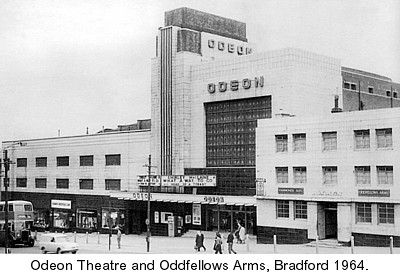 At this time in 1961, the shop units to the left of the entrance in what was known as Odeon Buildings were all still in use and providing a useful rental income for the cinemas. Occupants were . . .
At this time in 1961, the shop units to the left of the entrance in what was known as Odeon Buildings were all still in use and providing a useful rental income for the cinemas. Occupants were . . .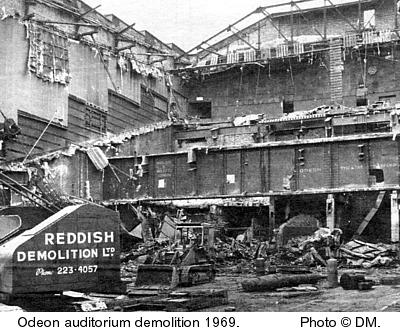 Within weeks Bradford City Council and Reddish Demolition Ltd had moved in to reduce the Odeon to rubble - a little more difficult than first imagined due to the very solid construction. (The Oddfellows Arms next door had been demolished earlier to make way for the new Jacob's Well roundabout and subway passages.)
Within weeks Bradford City Council and Reddish Demolition Ltd had moved in to reduce the Odeon to rubble - a little more difficult than first imagined due to the very solid construction. (The Oddfellows Arms next door had been demolished earlier to make way for the new Jacob's Well roundabout and subway passages.) Based on the Latin 'Odeium' and Greek 'Odeion' as in the famous Odeion of Herodes Atticus, the huge open air theatre at the foot of the Acropolis in Athens. It had been used earlier as a theatre name, eg. Odeon in Paris which suggested a luxury or even a classical touch. A business friend of Oscar Deutsch had also seen the name Odeon in Tunis and recommended it particularly as it started with 'OD' the initials of Deutsch.
Based on the Latin 'Odeium' and Greek 'Odeion' as in the famous Odeion of Herodes Atticus, the huge open air theatre at the foot of the Acropolis in Athens. It had been used earlier as a theatre name, eg. Odeon in Paris which suggested a luxury or even a classical touch. A business friend of Oscar Deutsch had also seen the name Odeon in Tunis and recommended it particularly as it started with 'OD' the initials of Deutsch.